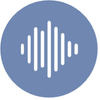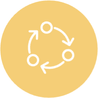Bone conduction candidacy, treatment determination, and care pathway

What you'll find on this page
- How to the determine appropriate Cochlear™ Bone Conduction Solutions for patients
- Patient fitting and outcome evaluation recommendations
- In-depth resources, including a comprehensive protocol for candidacy, evaluation, and fitting bone conduction solutions
Treatment determination and care pathway
Follow these steps for a consistent and streamlined candidacy and treatment process or download the Bone Conduction Protocol below. For more details, please go to the Resources section.
Download the Cochlear™ Bone Conduction Protocol
Download the Cochlear™ Pediatric Bone Conduction Protocol
Cochlear Bone Conduction Solutions candidacy, evaluation and fitting protocol
Candidacy identification
Assess audiological status, medical etiologies and impact to daily life to determine if bone conduction may be an appropriate solution.
- Type of hearing loss
- Conductive or Mixed hearing loss
- Bone Conduction Threshold Pure Tone Average (PTA)* ≤ 55 dB
- Patients with an air-bone gap (ABG) of > 30 dB PTA will experience significant advantages from a bone conduction system as compared to using an air conduction hearing aid.1
- Single-sided deafness
- Patients who have profound sensorineural hearing loss in one ear and normal hearing in the opposite ear
- Patients who cannot or will not use an air conduction CROS hearing aid
- Patient with contraindications for cochlear implantation
- Conductive or Mixed hearing loss
- Common etiologies (microtia/atresia, chronic otitis media, middle ear dysfunction/ossicular disease, or conditions contraindicating reliable use of conventional hearing aids)
- Daily interactions (struggle with communication, need for reliable and consistent hearing, and quality of life)
Demonstration and evaluation
Allow patients to experience hearing through bone conduction, providing patients with confidence in positive outcomes and appropriate expectations with a bone conduction solution.

- Conduct an aided demonstration to allow patients to experience hearing through bone conduction.
- Conduct a bone conduction evaluation to assess hearing and speech outcomes to assist with treatment determination, help predict outcomes, and collect a baseline for continued monitoring.
- Set appropriate expectations for patient outcomes through counseling.
Treatment determination
Develop an audiological treatment plan in conjunction with medical treatment to address hearing needs of the patient.
Patient qualification
|
Recommendation Cochlear™ Osia® System: Learn more
|
Patient qualification
|
Recommendation Cochlear Osia System: Learn more
or Conduct a cochlear implant evaluation for a Cochlear Nucleus® System: |
Patient qualification
|
Recommendation Cochlear™ Baha® Start with Baha 6 Max Sound Processor worn with a SoundArc™ or Softband: Learn more |
Additional recommendations for specific cases
Patient with factors that preclude an Osia 2 System |
Consider the Cochlear Baha Connect System with Baha 6 Max Sound Processor |
Baha Solution patient requiring additional clearance between their skin and the sound processor |
Consider the Baha 6 Max Sound Processor with the 2mm Extended snap coupling, instead of the LowPro™ snap coupling |
Patient with a bone conduction PTA threshold greater than 55 dB (500, 1000, 2000, 3000 Hz) |
Conduct a cochlear implant evaluation for a Cochlear Nucleus System |
Patient treatment, fitting and monitoring
Provide improved sound quality and speech intelligibility with comfortable wear for the recipient to use the device to their maximum potential.
- Cochlear Fitting Software allows for customization of the bone conduction fitting prescription and configuration of the sound processor to match the patient’s thresholds, profile, and individualized listening needs.
- Complete site checks as appropriate for the bone conduction solution at every visit and counsel the patient to perform regular site checks at home and report any issues immediately.
- The same outcomes measures used for candidacy can be used post-fitting to validate the fitting and allow comparison to the pre-treatment baseline and previous post-fitting intervals to monitor performance.
- Setting appropriate expectations is not only important in the candidacy process, but on an ongoing basis in order to help patients see their successes, identify their challenges, and continue to make progress.
- Consider utilizing available Remote Care** solutions to provide quality care without the need for patients to visit the clinic.
When to consider a medically necessary upgrade for your patient
As a clinician, you are ideally placed to understand the changing needs of your patients as you provide support and guidance throughout their hearing journey.
Three pathways to a medically necessary upgrade:
- Upgrade to a medically necessary new sound processor
- Transition from non-surgical bone conduction solution to surgical bone conduction solution
- Transition from an implantable solution to a new or different Cochlear implantable solution
Candidacy, evaluation and fitting resources
Disclaimer
This material is intended for health professionals. If you are a consumer, please seek advice from your health professional about treatments for hearing loss. Outcomes may vary, and your health professional will advise you about the factors which could affect your outcome. Always read the instructions for use. Not all products are available in all countries. Please contact your local Cochlear representative for product information.
For a full list of Cochlear’s trademarks, please visit our Terms of Use page.
* In the United States and Canada, the placement of a bone-anchored implant is contraindicated in children below the age of 5. In the United States and Canada, the Osia System is indicated for children ages 5 and older.
**Remote Assist for Baha for compatible Baha sound processors is intended for a follow-up adjustment or setup of a replacement or upgrade sound processor for suitable qualified patients based on clinical judgment. Only available at clinics that have enrolled in Remote Care.
†In the United States and Canada, the Nucleus System for single-sided deafness is approved for children ages 5 and older
For sound processor and app compatibility information visit www.cochlear.com/compatibility
References
- de Wolf MJ, Hendrix S, Cremers CW, Snik AF. Better performance with bone-anchored hearing aid than acoustic devices in patients with severe air-bone gap. Laryngoscope. 2011;121(3):613–616.







